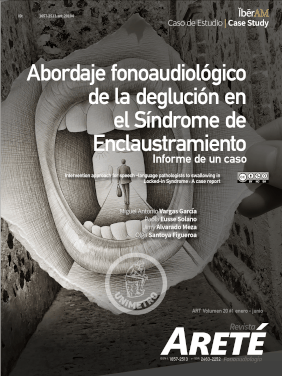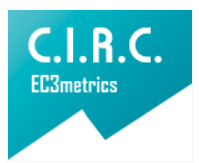Intervention Approach for Speech-Language Pathologist to Swallowing in Locked-In Syndrome
Abordaje Fonoaudiológico de la Deglución en el Síndrome de Enclaustramiento A case report.
Main Article Content
In the Locked-In Syndrome or LIS, the clinical manifestations are mainly related to the motor area. This situation requires the Speech and Hearing Therapist’s intervention, given the communicative involvement and the swallowing biomechanics in LIS is due to a sense and motor disconnection of the anatomical structure. This in turn alters the process ́s neuromotor and sensitive structures of the swallowing process, due to the pontine disconnection.
Given the multicenter characteristics of swallowing, the speech and hearing intervention must be realized in a timely manner, where the most important matter of the intervention must be the sequence of the neurophysiological processes; adopting as a basic strategy a consistency management for the strengthening of the sense and motor swallowing process. Upon intervention of the sensory and motor oral needs of the feeding and using as therapeutic strategies the modifying of consistencies, management of volume, posture, add-ons for food supplying and feeding time, the risks in the feeding process were minimized, and we were able to maintain an optimal nutritional and hydration state for the general physical recuperation. This process was developed side by side with better family interaction processes that have a positive impact in the quality of life.
Downloads
Publication Facts
Reviewer profiles N/A
Author statements
Indexed in
- Academic society
- Bogotá: Corporación Universitaria Iberoamericana
- Publisher
- Bogotá: Corporación Universitaria Iberoamericana
Article Details
Alvarez, C., Llorente, J., Gutierrez, V., Fernandez, H., Guervos, M., Suarez, C., & Hermen, M. (2007). Recidivas en el cáncer escamoso de cabeza y cuello. Acta Otorrinolaringol Esp, 58(4), 156-163.
American Cancer Society, NHC. (2015). Recuperado el 5 de Octubre de 2016, de Una guía sobre Radioterapia: http://www.cancer.org/acs/ groups/cid/documents/webcontent/003027-pdf.pdf
American Cancer Society, NHC. (2015). American Cancer Society. Recuperado el 5 de Octubre de 2016, de Guía sobre Radioterapia:
Arroyo-Aljaro, R., González-Viejo, M., & Rovira, A. (2008). Síndrome de locked-in. Una mirada a su tratamiento y pronóstico. Rehabilitación, 42(2), 92-95. doi:https://doi.org/10.1016/S0048-7120(08)73620-X
Barros, A., Silva, S., & De Angelis, E. (2010). Videofluoroscopia da deglutição orofaríngea. En G. Jotz, E. Carrara-De-Angelis, & A. Barros, Tratado de deglutição e disfagia: no adulto e na criança. (págs. 84-88). Rio de Janeiro: Revinter.
Belafsky, P., Blumenfeld, L., LePage, A., & Nahrstedt, K. (Nov de 2003). The accuracy of the modified Evan’s Blue Dye Test in
predigting aspiration. Laryngoscope, 113(11), 1969-72. doi :c10.1097/00005537-200311000-00021
Biblioteca Virtual de Salud. (15 de Mayo de 2018). Descriptores en Ciencias de la Salud. Obtenido de DeCS: http://decs.bvs.br/cgi-bin/wxis1660. exe/decsserver/
Cadena, E., Guerra, R., & Pérez-Mitchell, C. (Julio-Septiembre de 2014). Cirugía Robótica Transoral (TORS), en el manejo de lesiones
neoplásicas de cabeza y cuello. Revista Colombiana de Cancerología, 18(3), 128-136. doi:10.1016/j.rccan.2014.06.003
Cámpora, H., & Falduti, A. (2012). Evaluación y tratamiento de las alteraciones de la deglución. Rev Am Med Resp, 3(1), 98-107.
Cárcamo. (2018). Epidemiología y generalidades del tumor de cabeza y cuello. Revista Médica Clínica Las Condes, 29(4), 387-492.
doi:10.1016/j.rmclc.2018.06.009
Carcamo, M. (Ago de 2018). Epidemiología y generalidades del tumor de cabeza y cuello. Revista Médica Clínica Las Condes, 29(4), 387-492.
Clavé, P., Arreola, V., Romea, M., Medina, L., Palomera, E., & Serra-Prat, M. (2008). Accuracy of the volume-viscosity swallow test for clinical screeneng of oropharyngeal dysphagia and aspiration. Clinical Nutrition, 2(7), 806-15. doi:https://doi.org/10.1016/j.clnu.2008.06.011
Cola, P., Gatto, A., Gonçalves, R., Schelp, A., & Coelho, M. (2008). Reabilitação em disfagia orofaríngea neurogênica: sabor azedo e
temperatura fría. Rev. CEFAC, 10(2). doi:https://doi.org/10.1590/S1516- 18462008000200009
Costa, M. (2013). Controle Neural da Deglutição. En Deglutição & Disfagia: Bases Morfofuncionais e Videofluroscópicas (págs. 51-53). Rio de Janeiro: Medbook.
Denaro, N., Merlano, M., & Russi, E. (Sep de 2013). Dysphagia in Head and Neck Cancer Patients: Pretreatment Evaluation, Predictive Factors, and Assessment during Radio-Chemotherapy, Recommendations. Clinical and Experimental Otorhinolaryngology., 6(3), 117-126. doi:https://www.e-ceo.org/journal/view.php?doi=10.3342/ ceo.2013.6.3.117
European Society for Medical Oncology. (01 de 01 de 2015). Fundación contra el cáncer. Recuperado el 18 de 06 de 2019, de ESMO: ESMOACF-Cancer-de-Cabesa-y-Cuello-Guia-para-pacientes.pdf
Fiorelly, A., Fausto, F., Nagar, F., Fusco, P., Mazzone, S., Costa, G., . . . Santini,M. (31 de abril de 2017). A New Modified Evans Blue Dye Test as Screening Test for Aspiration in Tracheostomized Patients. Journal of cardiothoracic and vascular anesthesia., 2, 441-445. doi.org/10.1053/j.jvca.2016.07.031
Flores, K., Berretin-Felix, G., Beltrati, M., & Queiroz, I. (ABRIL-JUNIO de 2009). Avaliação miofuncional orofacial - Protocolo MBGR. CEFAC, 11(2), 237-255.
Frowen, J., Hughes, R., & Skeat, J. (2019). The prevalence of patientreported dysphagia and oral complications in cancer patients. Supportive Care in Cancer, doi: 10.1007/s00520-019-04921-y. Furkim, A., & Freitas, A. (2008). Eficácia da fonoterapia em disfagia
neurogênica usando a escala funcional de ingestão por via oral (FOIS) como marcador. Rev CEFAC, 10(4), 503-512. doi:https://doi.
org/10.1590/S1516-18462008000400010
Greenblatt, D., Sippel, R., Leverson, G., Frydman, F., Schaefer, S., & Chen, H. (2009). Thyroid Resection Improves Perception of Swallowing Function. World Journal of Surgery, 33, 255-260. doi:10.1007/s00268- 008-9837-9
Guevara, E., Avendaño, S., Salazar, A., Alarcón, M., & Santelices, M. (2016). Contribución de la temperatura fría y el sabor ácido en la
intervención fonoaudiológica de la disfagia orofaríngea. Revista Chilena de fonoaudiología, 15, 1-9. doi:10.5354/0719-4692.2016.44206
Hamilton, S., Yoo, J., Hammond, A., Read, N., Venkatesan, V., Franklin, J., Badhwar, A. (Oct de 2008). Microvascular changes in radiationinduced oral mucositis. J Otolaryngol Head Neck Surg, 37(5), 730- 737.
Hutcheson, K., Lewin, J., Barringer, D., Lisec, A., Gunn, B., Moore, M., & Holsinger, C. (2012). Late Dysphagia After Radiotherapy-Based
Treatment of Head and Neck Cancer. Cancer, 118(23), doi: 10.1002/ cncr.27631.
International Dysphagia Diet Standardisation Initiative. (10 de October de 2016). Complete IDDSI framework and descriptors. Obtenido de iddsi.org/translation: https://iddsi.org/wp-content/uploads/2018/05/
Marco_y_descriptores_de_la_IDDSI_FOR_REVIEW.pdf International Dysphagia Diet Standardisation Initiative. (01 de Agosto de 2018). International Dysphagia Diet Standardisation Initiative. Obtenido de IDDSI: http://iddsi.org/
Joung, S., Woo, K., Beom, S., Hwa, J., & Kyu, M. (Oct de 2015). Voluntary Cough and Swallowing Function Characteristics of Acute Stroke Patients Based on Lesion Type. Archives of Physical Medicine and Rehabilitation, 96(10), 1866-1872. doi:https://doi.org/10.1016/j. apmr.2015.06.015
Khanna, K., Verma, A., & Richard, B. (December de 2011). The locked-in syndrome: Can it be unlocked? Journal of Clinical Gerontology and Geriatrics, 2(4), 96-99.
Lazarus, C. (Jun de 2009). Effects of chemoradiotherapy on voice and swallowing. Curr Opin Otolaryngol Head Neck Surg, 17, 172-178.
Lazarus, C., Ward, E., & Yiu, E. (2014). Speech and Swallowing following oral, oropharyngeal and nasopharyngeal cancers. En E. Ward, & C. Van As-Brooks, Head and Neck Cancer: Treatment, Rehabilitation, and Outcomes (págs. 173-240). San Diego, California: Plural Publishing.
Liga contra el cáncer. (01 de 01 de 2016). Liga contra el cáncer seccional Bogotá. Recuperado el 18 de 06 de 2019, de http://www.
ligacontraelcancer.com.co/cancer-de-cabeza-y-cuello/
Liga Contra el Cáncer. (01 de 01 de 2016). Liga contra el cáncer seccional Bogotá. Recuperado el 18 de 06 de 2019, de http://www. ligacontraelcancer.com.co/cancer-de-cabeza-y-cuello/
Logemann, J., Pauloski, B., Rademaker, A., & Colangelo, L. (1 de Mayo de 1997). Speech and swallowing rehabilitation for head and neck cancer patients. Oncology (Williston Park), 11(5), 659-664.
Lujan Ramos, V. P., Monterrosa-Salazar, E., & Polo-Verbel, L. (2011). Síndrome de enclaustramiento: a propósito de un caso. Revista Ciencias Biomédicas, 2(1), 116-120.
Lyndell, K. (2014). Radiation and Chemotherapy. En E. Ward, & C. Van as-brooks, Head and neck cancer: treatment, rehabilitation, and
outcomes (Second Edition ed., págs. 63-102). San Diego, California: Plural Publishing.
Mansueto, A., Aguiar, S., Oliveira, e., Caseiro, L., & Teixeira, A. (2016). Frequência e fatores associado à disfagia após acidente vascular
cerebral. CoDAS, 28(1), 66-70. doi:https://doi.org/10.1590/2317- 1782/20162015072
Martínez, M., & Bellido, D. (2003). Nutrición y disfagia. Fisioterapia, 25(5), 306-310. doi:https://doi.org/10.1016/S0211-5638(03)73069-7
Ney, D., Weiss, J., Kind, A., & Robbins, J. (2009). Senescent Swallowing: Impact, Strategies and Interventions. Nutr Clin Pract., 24(3), 395–413. doi:doi:10.1177/0884533609332005
Nickel, B., Tan, T., Cvejic, E., Baade, P., McLeod, D., Pandeya, N., . . . Jordan,S. (17 de 01 de 2019). Health-Related Quality of Life After Diagnosis and Treatment of Differentiated Thyroid Cancer and Association With Type of Surgical Treatment. JAMA Otolaryngology–Head & Neck Surgery, e1-e8. doi:10.1001/jamaoto.2018.3870.
Nickel, B., Tan, T., Cvejic, E., Baade, P., McLeod, D., Pandeya, N., . . . Jordan, S. (17 de jan de 2019). Health-Related Quality of Life After Diagnosis and Treatment of Differentiated Thyroid Cancer and Association With Type of Surgical Treatment. JAMA Otorinolaryngology - Head & Neck Surgery, 231-238. doi:10.1001/jamaoto.2018.3870

















